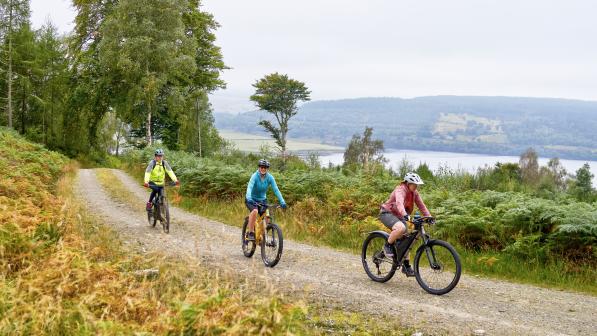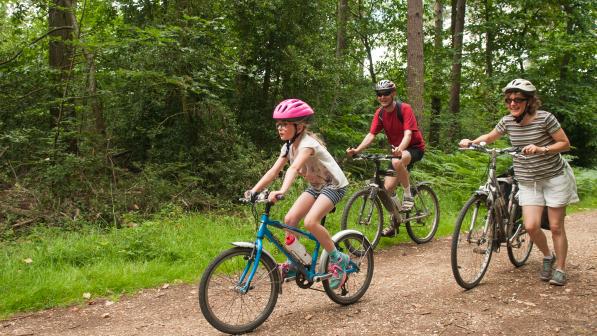How to keep cycling into old age

It’s not so long ago that as soon as you hit 60 (or even younger) you were advised to slow down, take it easy and wrap yourself in cotton wool. Nowadays, the advice has flipped and we’re being told to stay active as much as possible.
This is great news for cyclists who want to keep cycling as they get older. If you want to continue riding as you hit 60, 70 or beyond, there’s no reason not to – and many reasons to do so. In fact, Cycling UK member Peter Langford celebrated his 90th birthday by cycling the length of the country, from the southern tip at Land’s End to the northernmost point of John o’ Groats. He says: “When I get on the bike I feel 30 years younger!”
Why keep cycling
If you ride a bike – whether that’s to work or the shops, long-distance road rides or off-road adventures – then you already know the many benefits. But there are also benefits specific to ageing.
Cycling is low impact as you’re supported by the bike. This means it’s kinder to your joints and you’re less likely to get injured – as we get older it takes longer to recover from injuries so preventing them from the outset is a good thing.
It’s also great for the cardiovascular system – meaning your heart, blood vessels and blood that all work together to circulate blood through the body to deliver oxygen and nutrients and remove waste products. It’s also good for reducing the risk of chronic diseases such as Type 2 diabetes.
The risk of loneliness can increase as we get older, too. The social aspect of cycling can really help here. Cycling UK has more than 1,000 member and affiliated groups across the country as well as a network of Community Cycle Clubs. Joining one of these will provide motivation as well as that all-important social connection.
Cycling is especially good at working the lower body, and as we get older we need to keep our legs strong – after all we need them for walking, getting up and down stairs and standing up out of chairs. Losing strength in your legs means you’re more likely to become isolated, too, as going out and seeing other people becomes harder.

However, as we get older it becomes more important to keep an eye on your health. It’s recommended that you get annual health checks and listen to your body – if you don’t feel up to riding, give yourself a day off. You’ll thank yourself for it in the long run.
Please also check with your GP before undertaking any new activities or exercise regime. The tips given here aren’t medical advice.
Get the bike right
As you get older you might find you need to consider changing your bike, or at least the bike setup. If you’re finding harder to get up those hills or carry your shopping home, or you’re finding yourself left behind on club runs, an e-bike could be the answer.
You’ll probably find that your mobility and flexibility are changing – although more on that later – so you might want to try out a step-through frame so you don’t have to fling your legs up over your saddle. If balance starts to become an issue as you age, a trike could keep you riding safely.
If you don’t want to change your bike just yet, think about having a bike fit. Even small changes in your setup can lead to big improvements in your comfort. You can even try doing it yourself with our advice.
Spice it up
What they say about life applies to cycling too: variety should be your watchword. Mixing things up will keep your cycling interesting and allow you to work on different areas of fitness. Trying something new is good for keeping your brain young as well as your body – if bikepacking is something that interests you but you’ve never given it a go, now is the time.
Incorporate rides of different intensity, duration and frequency. You could try a couple of weeks of lots of shorter, faster rides combined with shorter, slower ones, then have a few weeks of one or two longer rides.

Older cyclists often sacrifice intensity for duration, tending to go for long rides at a slower pace. However, keeping up the intensity as well will improve your performance on the bike, keeping you riding as the years progress.
Consistency is key, here. The more cycling you do, the more you’ll be able to do. Make it part of your life – get on the bike to see friends, go shopping, visit a local coffee shop. If you’re still working cycle to work a few days a week.
It’s not necessarily about pushing yourself harder every time – you’re not training for the Tour de France after all. It’s about keeping things interesting and improving your own performance and fitness so that you can carry on doing the riding you want to do.
I’ve noticed an improvement in my weekend leisure rides having cycled to work just one day a week. I feel stronger on my road bike just with that little bit of extra riding on a heavier bike loaded down with a packed pannier. I’m more comfortable going further and faster – if I want to.
That said, there’s nothing wrong with challenging yourself – if that’s what you want to do!
Cross training
This is just a fancy term for ‘activity other than cycling’. In your younger years you could probably get away with just cycling and that was enough to keep health and fitness at their peak. This changes as you get older and it becomes more important to incorporate other forms of exercise into your routine.
You should prioritise strength training. We all lose muscle mass and strength as we get older – known as sarcopenia. This starts to happen from around 30 years old but it speeds up as you age and is a particular issue for peri- and post-menopausal women.
Regular strength training, however, will help to off set this. This doesn’t have to be heavy lifting in the gym. Body weight exercises such as squats, lunges, push-ups and pull-ups work just as well. If you want to, you can always invest in some dumbbells for added intensity.

If you’re unsure where to start, there are loads of programmes you can follow on YouTube. Personally, I use Heather O’Connor and Caroline Girvan.
You should also work on your mobility and flexibility as you tend to stiffen up as you get older. This is especially true if you spend much of your day sitting. Stiffness can make sitting on a bike very uncomfortable; you don’t want to have to give up cycling due to pain in your back or shoulders.
Just 10 minutes of basic stretching can help keep you limber. Practices such as yoga or Pilates are even better. Again, YouTube is your friend if you need some advice. However, if you’ve never tried yoga or Pilates before, it’s best to start with a few beginner classes so a teacher can check your posture and alignment. A class also has the added benefit of social connection.
Improving strength and flexibility will have the knock-on effect of improving your balance too, which is essential for cycling. For days off the bike, walking and swimming are both excellent low-impact activities.
Nutrition
Eating right is important at any age, but especially so as you get older. Your metabolism starts to slow down after around 60, but if you’re very active you’ll still need to ensure you fuel yourself properly.
A good source of protein is key. Contrary to what you might have been told in the past, this doesn’t have to be meat. Nuts, seeds, beans, lentils, tofu and tempeh are all excellent plant-based sources of protein. Dairy, eggs and oily fish are also good – this last is also a great source of healthy fats, as is olive oil.
Bulking out your diet with loads of different fruits and vegetables will fill you up and provide a whole load of nutrients. The more colourful your plate the better!

I’ve increased my own protein intake by adding tempeh and lots of different seeds to salads and breakfasts and making my own cashew cream and mixing it into homemade sauces and curries.
Recovery
We all remember those heady days when you could spend hours in the saddle, cycling for miles, and then get up and do the same the next day and maybe the day after that. But as we age, the time we need to recover increases.
Give yourself plenty of rest and recovery time throughout the day. You could also check out meditation or mindful breathing to help you relax.
This doesn’t mean you have to give up multi-day touring if that’s your thing. Instead give yourself plenty of time so that you can build in some shorter days in the saddle and a couple of extra rest days.
There are also a few products you can invest in to help with recovery if you want to. These include compression socks, protein shakes, massage guns and foam rollers – or you could go the whole hog and treat yourself to a professional massage.
You should also prioritise sleep. You produce less human growth hormone – which is necessary to maintain tissues and organs throughout life – as you age and getting plenty of sleep will help maximise what you do produce.
One final bit of advice: don’t compare yourself to younger riders, or to your younger self. Celebrate what you can do, enjoy the ride and be kind to yourself. You’ll be able to continue cycling as the years advance.
We all decline as we age, but cyclists remain among the fittest members of society. Being a bit slower than you were 10 years ago really doesn’t matter – what does matter is that you’re still out there riding your bike and enjoying it.

